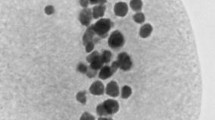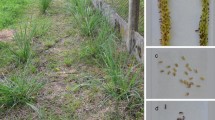Abstract
Self-pollinations of a diploid (2n = 2x = 16) interspecific hybrid Alstroemeria aurea × A. caryophyllaea, resulted in no seeds. Backcrosses of the hybrid with parent A. aurea did not produce any seeds. In an attempt to restore the hybrid fertility, an efficient in vitro procedure has been developed and applied effectively in the chromosome doubling of the diploid hybrid. Forty-one percent of the treated plants were proven to be truly tetraploid by chromosome counts and stomatal measurements after applying 0.2 to 0.6% colchicine for 6 to 24 hours. Over 87.5% of these colchicine-induced tetraploids were stable and retained their tetraploidy after one year of growth. The fertility of the hybrid was not restored although the pollen stainability was increased from 0 to 12% after chromosome doubling. Cytological studies on the pollen mother cells (PMCs) of the sterile diploid hybrids revealed abnormal meiotic behaviors. In addition, aneuploid chromosome numbers, ranging from 2n = 1 to 2n = 18, were observed in over 45% of the PMCs examined. PMCs of the colchicine-induced tetraploids showed that meiotic chromosome pairings were normal in most cases (1.59I + 15.07II + 0.05III + 0.03IV). These results indicate that the sterility of this hybrid is not only caused by parental chromosome differences, but other complex fertility/sterility-regulating mechanisms are involved too.
Similar content being viewed by others
References
Anderson, J.A., G. Mousset-Declas, E.G. Williams & N.L. Taylor, 1991. An in vitro chromosome doubling method for clovers (Trifolium ssp.). Genome 34: 1–5.
Barnabas, B., P.L. Pfahler & G. Kovacs, 1991. Direct effect of colchicine on the microspore embryogenesis to produce dihaploid plants in wheat (Triticum aestivum L.). Theor Appl Genet 81: 675–678.
Bridgen, M.P., 1991. Alstroemeria — a promising pot plant. In: Vic Ball (Ed.), Ball Redbook, 15th Ed., pp. 316–318.
Bridgen, M.P., 1992. Alstroemeria. In: A.A. Dehertogh & M. LeNard (Eds.), The Physiology of Flower Bulbs — A Comprehensive Treatis on the Physiology and Utilization of Ornamental Flowering Bulbous and Tuberous Plants.
Chen, C.H. & Y.C. Goeden-Kallemeyn, 1979. In vitro induction of tetraploid plant from colchicine-treated diploid daylily callus. Euphytica 28: 705–709.
Cua, L.D., 1951a. Fertile tetraploid of japonica × indica in rice. Proc Jpn Acad 27: 43–48.
Cua, L.D., 1951b. A newly devised colchicine method for inducing polyploid in rice. Bot Gaz 112: 327–329.
Griesbach, B.A., 1981. Colchicine-induced polyploidy in Phalaenopsis orchids. Plant Cell, Tissue & Organ Culture 1: 103–107.
Hang, A. & T. Tsuchiya, 1988. Chromosome studies in the genus Alstroemeria. II. Chromosome constitutions of eleven additional cultivars. Plant Breeding 100: 273–279.
Hauser, E.J.P. & J.P. Morrison, 1964. The cytochemical reduction of nitro blue tetrazolium as an index of pollen viability. Amer J Bot 51: 748–752.
Hermsen, J.G.Th., M.S. Ramanna & Z. Sawor, 1981. The effect of chromosome doubling on fertility, meiotic behavior and crossability of Solanum tuberosum × S. pinnatisectum. Euphytica 30: 33–39.
Jan, C.C. & J.M. Chandler, 1989. Sunflower interspecific hybrids and amphiploids of Helianthus annuus × H. bolanderi. Crop Sci 28: 643–646.
Loegering, W.Q. & E.R. Sears, 1963. Distorted inheritance of stemrust resistance of timerstein wheat caused by a pollen-killing gene. Can J Genet Cytol 5: 67–72.
Lu, C.S., 1995. Conventional and biotechnological approaches for the genetic improvement of Alstroemeria.Ph.D. Dissertation, University of Connecticut, Storrs, USA.
Lu, C.S. & M.P. Bridgen, 1996. Effects of genotype, culture medium and embryo developmental stage on the in vitro responses from ovule culture interspecific hybrids of Alstroemeria. Plant Sci 116: 205–212.
Murashige, T. & F. Skoog, 1962. A revised medium for rapid growth and bioassays with tobacco tissue cultures. Physiol Plant 15: 473–497.
Ramanna, M.S., 1992. The role of sexual polyploidization in the origins of horticultural crops: Alstroemeria as an example. In: Proc of the Workshop — Gametes with Somatic Chromosome Number in the Evolution and Breeding of Polyploid Polysomic Species: Achievements and Perspectives. Perugia, Italy.
Rick, C.M., 1966. Abortion of male and female gametes in the tomato determined by allelic interaction. Genetics 53: 85–96.
Sano, Y., 1983. A new gene controlling sterility in F1 hybrids of two cultivated rice species. J Hered 74: 435–439.
Sano, Y., 1990. The genic nature of gamete eliminator in rice Genetics 125: 183–191.
Sano, Y., 1993. Is an egg-killer present in rice? Theor Appl Genet 86: 1038–1042.
Sano, Y., Y.E. Chu & H.I. Oka, 1979. Genetic studies of speciation in cultivated rice. 1. Genic analysis for the F1 sterility between O. sativa L. and O. glaberrima Steud. Jpn J Genet 54: 121–132.
Tsuchiya, T. & A. Hang, 1987. Chromosome studies in genus Alstroemeria. Acta Horticulturae 205: 281–287.
Tsuchiya, T. & A. Hang, 1989. Cytogenetics in the genus Alstroemeria. Herbertia 45 (1 & 2): 163–170.
Tsuchiya, T., A. Hang, W.E. Healy & H. Hughes, 1987. Chromosome studies in the genus Alstroemeria. I. Chromosome numbers in 10 cultivars. Bot Gaz 148(3): 519–524.
Wan, Y., J.F. Petolino & J.M. Widholm, 1989. Efficient production of doubled haploid plants through colchicine treatment of anther-derived maize callus. Theor Appl Genet 77: 889–892.
Author information
Authors and Affiliations
Rights and permissions
About this article
Cite this article
Lu, C., Bridgen, M.P. Chromosome doubling and fertility study of Alstroemeria aurea × A. caryophyllaea. Euphytica 94, 75–81 (1997). https://doi.org/10.1023/A:1002911522748
Issue Date:
DOI: https://doi.org/10.1023/A:1002911522748




